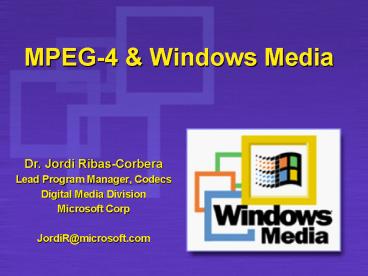MPEG-4 PowerPoint PPT Presentation
1 / 13
Title: MPEG-4
1
MPEG-4 Windows Media
- Dr. Jordi Ribas-Corbera
- Lead Program Manager, Codecs
- Digital Media Division
- Microsoft Corp
- JordiR_at_microsoft.com
2
Overview
- Digital Media Introduction
- Windows Media Technologies and MPEG-4
- MPEG-4 status in industry
- Benefits of MPEG-4
- Microsoft efforts in MPEG-4
- Challenges facing MPEG-4
- Microsofts position on MPEG-4
- Summary
3
Digital Media World
- Many devices
- Wired or wireless
- Access from anywhere
- Software Integration
- Personalized delivery
Rich Services
4
Windows Media Tech
Live Content
License Server
Download Play Streaming
Live Feed
On-demand Content
Windows Media Encoder
Windows Media Services Server
Windows Media Player PC, Hand-held, STB
Streaming from a WM Server (or Web Server)
Stored Content
Authoring
Playback
Distribution
5
Windows Media Tech and MPEG4
WMT
Windows Media Player
Windows Media Encoder
Windows Media Rights Manager
Windows Media Format (ASF Codecs DRM)
Windows Media SDK
Windows Media Services
Windows Media Embedded PAK
WM Format CODECSWindows Media Video Windows
Media Audio ISO MPEG-4 Video Windows Media Screen
6
MPEG-4 Status in Industry
- Several companies are implementing different
parts of MPEG-4 in their products - Apple, Envivio.com, E-vue, Fraunhofer, Ivast,
Matsushita, Microsoft, Philips, Sharp, Toshiba,
- First successful interoperable products
(developed independently) using MPEG-4 Video - Sharps Internet ViewCam and Microsofts Windows
Media Player, in 1999 - NTT DoCoMo Eggy wireless terminal and
Microsofts Windows Media Encoder and Player, in
2000 - Some tools for creating and authoring MPEG-4
format emerging
7
Benefits of MPEG-4
- Standards are helpful for interoperability
- Follows successful MPEG-1 and MPEG-2 efforts
- Improved quality over previous MPEG standards
- E.g., MPEG-4 Video (version 1) saves 15-25 of
bit rate over MPEG-2 -- according to MPEG-4
tests - Larger set of target applications over previous
MPEG standards - From very low to very high bit rates
- Multiple codecs for different media (voice, still
image, etc.) - Several companies are already implementing parts
of the standard
8
Microsoft Efforts in MPEG-4
- Actively participant since 1995 to help develop
MPEG-4 - 100 contributions ? focused on Video coding
- Contributed C official version of Verification
Model (VM) Video software (enc/dec) to ISO - Current MPEG Video Chairman is from Microsoft
- Created essential IP used in standard
- Participating in MPEG-4 Video Patent Pool
(currently there are 19 companies in M4VisualPHG) - Helped make MPEG-4 popular in industry
- Supported MPEG-4 Video codec in Windows Media
Technologies - Partnered with companies using MPEG-4 Video
- Interoperating with products / services from NTT
DoCoMo, Sharp, - Demo
9
Challenges Facing MPEG-4
- Huge standard ? limits interoperability
- Video with 20 profiles (simple, core, main,
still texture, streaming, advanced simple, etc.),
Graphics (SHNC, FAPs), Audio, Speech, Systems
(File Format, Bifs, DMIF) - Many versions V1, V2, V3, V4
- MPEG-4 is a large set of tools that companies
pick and choose - MPEG-4 video quality not competitive with state
of the art in compression - Other emerging Standards such as ITU-T H.26L
claim better performance - E.g., see Q15-H-21 in ftp//standard.pictel.com/vi
deo-site/9908_Ber, 1999. - Popular internet codecs already providing better
quality - E.g., Real Video 8 and Windows Media Video 8
- New video codec effort starting in MPEG
- Some features are unproven commercially as of now
- E.g., object-based coding, sprites, SHNC, FAPs,
Bifs, - MPEG-4 lacks complete solution for end-to-end
delivery - No Digital Rights Management, Screen codec,
Networking protocols/Server (with system layer) - Licensing of MPEG-4 not yet clear
10
Microsofts Position on MPEG-4
- Microsoft continues support of MPEG-4 video for
interoperability - Microsoft continues to innovate with Windows
Media - Customers demand the best quality
- State-of-the-art Windows Media Video and Audio
codecs - Complete end-to-end solutions
- Digital Rights Management
- High-performance streaming protocols/server
- Specialized codecs such as Windows Media Screen
11
Summary
- Microsoft provides support for MPEG-4 video today
for interoperability - MPEG-4 is a broad standard and likely not all
components will achieve commercial viability - Other technologies are also needed to meet
customers requirements - Customers can choose interoperability or better
quality / feature set with Windows Media
12
Q A
- For more information
- http//microsoft.com/windowsmedia
- http//msdn.microsoft.com/windowsmedia
13
(No Transcript)

